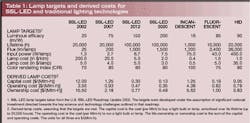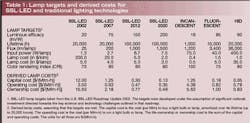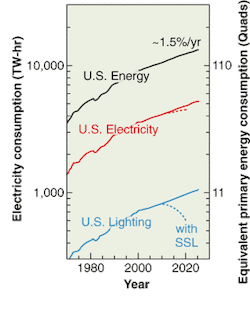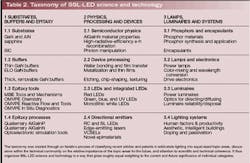Roadmap projects significant LED penetration of lighting market by 2010
A quiet revolution is under way. During the next five to ten years semiconductor-based solid-state lighting (SSL) is expected to outperform first incandescence, then fluorescence and high-intensity discharges (HID), for general illumination.1 Along the way, many decision points and technical challenges will be faced. These challenges were outlined in recent comprehensive updates of two SSL roadmaps, co-sponsored by the U.S. Department of Energy and the Optoelectronics Industry Development Association (Washington, DC).2
The two roadmaps cover inorganic light-emitting diodes (LEDs; also co-sponsored by the National Electrical Manufacturers Association (Rosslyn, VA) and organic light-emitting diodes (OLEDs) for general illumination. Of these two technologies, LEDs are more advanced and likely to be first to enter general illumination applications. We will review the SSL-LED roadmap: the high-level targets, the anticipated benefits of meeting those targets, and the taxonomy of the science and technology challenges that will need to be surmounted along the way.
SSL-LED lamp targets
The high-level targets for SSL-LED lamps are listed in the top part of Table 1. The first four columns represent the performance of current and projected future SSL-LED technology; the last three columns represent the performance of traditional lighting technologies.
Except for one—the color rendering index—these targets were chosen based on "hard" economic competitiveness rather than on "soft" features, such as color flexibility and programmability. With that in mind, the last three rows of the table also show the capital, operating, and life-ownership costs of the various lighting technologies. The roadmap anticipates a life-ownership cost for SSL-LEDs to be lower than that of incandescence in five years, and lower than those for fluorescence and high-intensity discharges in 10 years.
Benefits of SSL-LEDs
If the roadmap targets are met, then we anticipate significant displacement of traditional lighting beginning in 2010 (see Fig. 1). This displacement will enable three primary benefits.
FIGURE 1. Historical and projected U.S. electricity consumption for all uses and for lighting, with and without solid-state lighting indicate significant displacement of traditional lighting by 2010. Figures are adapted from the "price breakthrough" case discussed by Mark Kendall and Michael Scholand, using more recent electricity figures and consumption projections from the Energy Information Agency's Annual Energy Outlook 2003 and from a recent lighting inventory by Navigant Consulting.3, 6, 7
First is the impact on energy consumption. In the U.S., about one-third of all primary energy is used to produce electricity, and of this electricity about one-fifth is used to produce light. Assuming an electricity-consumption mix of 42% incandescence, 41% fluorescence, and 17% high-intensity discharges, and using the efficiencies listed in Table 1, the current aggregate efficiency of lighting can be estimated to be in the range 45 to 65 lm/W.3 If SSL-LEDs achieve their long-term target of 150 to 200 lm/W, we can expect the aggregate efficiency of lighting to more than double. Note, though, that complete displacement will not be trivial—even if all targets are met, it will only follow if widespread consumer acceptance can be achieved, and even then will occur with a time lag associated with the finite rate of market penetration and diffusion for any new technology.
Then, the electricity used for lighting would be cut in half, and the electricity used for all purposes would decrease by more than one-tenth. In the U.S., by the year 2025 electricity consumption is projected to be roughly 5250 TW-h/yr, or, at an average retail price of $0.07/kW-h, roughly $350 billion per year to the consumer. Hence, the electricity savings would exceed 525 TW-h/yr, or roughly $35 billion per year to the consumer. Worldwide, the figures are all about a factor of three or four higher.
The case for a national investment in SSL research and development is compelling. If the displacement of traditional lighting by solid-state lighting can be accelerated by even one year, U.S. consumers would save roughly $35 billion; if accelerated by more than one year, the savings would be proportionately more.
To put this in a different perspective, note that the average nuclear power plant in the U.S. generates about 7.2 TW-h/yr of electricity (this translates, assuming 365 × 24 h/yr and 1999's average utilization rate of 87%, to about 1 GW of generating capability per power plant).4 Hence, 525 TW-h/yr less generating capacity needed implies 525/7.2, or roughly 70 fewer nuclear power plants projected to be needed by the year 2025.
The second benefit is the indirect impact of this reduced electricity consumption on the environment. With the current electricity-generation-technology mix in the U.S. approximately 1 Mton of carbon (C)-equivalent emissions is produced for every 6 TW-h of electricity consumed. Assuming a similar electricity-generation technology mix in the year 2025, roughly 87 Mtons of C-equivalent emissions would be saved every year. We can put this into perspective in two ways.
The Kyoto protocol, though not yet ratified by the U.S., specifies that C-equivalent emissions in most of the developed countries, including the U.S., be reduced to 7% below 1990 levels, or roughly 40% below projected 2025 levels.5 If, by that year, solid-state lighting decreases primary energy consumption and associated C-equivalent emissions by 3%, than solid-state lighting would move the U.S. about 7.5% toward meeting the Kyoto protocol.
Regardless of the Kyoto protocol, the U.S. is likely to adopt some type of C-emissions trading market. Estimates for the price associated with such trading are on the order $5 per ton.6 Hence, an 87 Mton/yr savings in C emissions would enable a C-emissions-trading savings of on the order $0.4 billion/yr.
The third benefit is the impact on the overall human visual experience of new features associated with solid-state lighting. For example, the color and brightness of SSL can in principle be independently tuned and programmed, while maintaining high efficiency. The compactness, shock-resistance, and low-voltage operation will enable integration with a wide range of architectural and human environments. And the "point-source" nature of SSL will enable the light to be directed and distributed in efficient, innovative ways into the human environment.
It is difficult to quantify the benefits of such enhancements in the human visual experience. However, we note that even a conservative 0.1% improvement in human productivity would, in a U.S. economy with a gross domestic product of about $10 trillion/year, represent a benefit of $10 billion/year.
Such benefits may even drive a turnover in lighting systems before existing lamps or luminaires burn out, and before their energy efficiency has exceeded that of the current aggregate for traditional lighting. If so, the overall lighting market could grow at a rate significantly faster than the historical 3% per year associated with traditional lighting; and aggregate lighting efficiency could decrease during an interim period.
SSL-LEDs roadmap research thrusts
The benefits of SSL-LEDs, of a substantial national investment in its research and development foundation, and of accelerating its displacement of traditional lighting technologies are clear.
The targets listed in Table 1 are intended to enable such displacement. They are also physically reasonable and consistent with our knowledge of fundamental physics and with other, more mature, semiconductor manufacturing technologies. Nevertheless, they are aggressive: solid-state lighting is in its infancy, just as silicon integrated circuits were in their infancy three decades ago.
Hence, in a six-month process (February to August 2002), a community of experts from universities, national laboratories and industry worked to identify the most significant challenges requiring substantial research and development. The challenges were organized into a taxonomy (see Table 2). The challenges encompassed the full range of longer-term fundamental research to shorter-term engineering development. Examples include several areas.
Area 1 (substrates, buffers, and epitaxy). A fundamental understanding of epitaxy tools and mechanisms over the full range of aluminun gallium indium nitride (AlGaInN) quaternary compositions and doping levels is considered essential to broadening the possibilities for bandgap nanoengineered heterostructures. And the development of low-defect-density GaN or AlN substrates, either through bulk growth of boules or through novel combinations of thick and thin buffers, is considered essential to achieving devices that can be driven hard—to maximize light output per unit semiconductor chip area—while maintaining high-efficiency and long lifetimes.
Area 2 (physics, processing, and devices). A fundamental understanding of the physics of photon creation, manipulation, and extraction—in both spontaneous and stimulated emission structures—is considered essential to ultimately achieving 50% power-conversion efficiency. And the development of novel device designs, particularly for the creation of white light without the use of phosphors, is considered high-risk but also high-payoff, as it would enable white light to be created at the chip (rather than at the package) level.
Area 3 (lamps, luminaries, and systems). A fundamental and quantitative understanding of the relationship between human productivity and the potential features associated with solid-state lighting will be needed to understand what features and approaches to solid-state lighting to emphasize. And the development of new, high-operating-temperature and low-degradation-rate phosphors which absorb in the blue or near-ultraviolet and emit with near-100% quantum efficiency at all three primary colors is considered essential to achieving high color-rendering-index white light.
We emphasize that for many of these challenges, there are as yet no known approaches. Hence, the coming decade will be full of both uncertainties and excitement for lighting.
ACKNOWLEDGMENT
We acknowledge: the many contributors to the SSL-LED Roadmap Update 2002; the sponsorship of that Roadmap Update by the Department of Energy, the Optoelectronics Industry Development Association and the National Electrical Manufacturers Association; the Sandia Solid-State Lighting Team, managed by Jerry Simmons, Bob Biefeld and James Gee; and helpful comments on this manuscript by Arpad Bergh (OIDA), James Gee (Sandia), and Michael Scholand (Navigant Consulting). Sandia is a multiprogram laboratory operated by Sandia, a Lockheed Martin Company, for the United States Department of Energy under Contract DE-AC04-94AL85000.
REFERENCES
- See, for example, http://lighting.sandia.gov/.
- J. Y. Tsao, Ed., Light Emitting Diodes (LEDs) for General Illumination Update 2002, (Optoelectronics Industry Development Association, Washington D.C., 2002); and M. Stolka, Ed. Organic Light Emitting Diodes for General Illumination Update 2002 (Optoelectronics Industry Development Association, Washington D.C., 2002).
- Navigant Consulting, U.S. Lighting Market Characterization (U.S. Department of Energy, Office of Building Technologies, www.eren.doe.gov/buildings/documents/, September, 2002).
- .Statistics from the Nuclear Energy Institute (http://www.nei.org/index.asp?catnum=3&catid=37)
- Energy Information Agency (EIA), Impacts of the Kyoto Protocol on U.S. Energy Markets & Economic Activity, http://www.eia.doe.gov/oiaf/kyoto/kyotorpt.html, (October 1998).
- www.pointcarbon.com
- www.eia.doe.gov/oiaf/aeo/figure_4
- M. Kendall and M. Scholand, Energy Savings Potential of Solid State Lighting in General Lighting Applications (U.S. Department of Energy, Office of Building Technology, State and Community Programs, April 2001).
JEFFREY Y. TSAO is principal member of the technical staff at Sandia National Laboratories, P.O. Box 5800, Albuquerque, NM 87185-0601; e-mail: [email protected].



